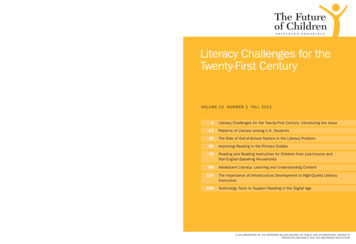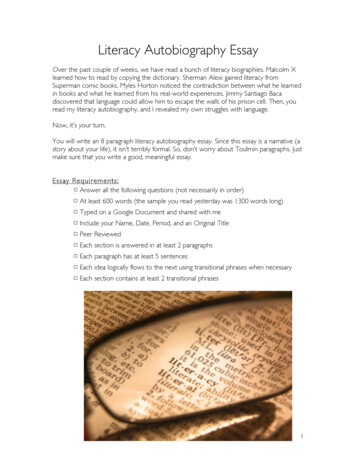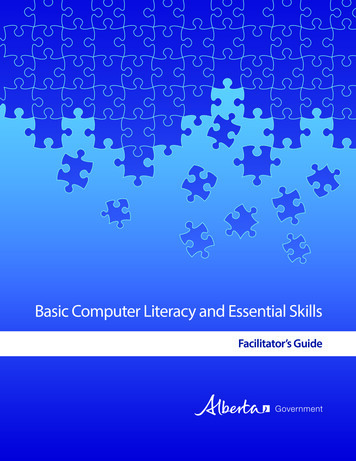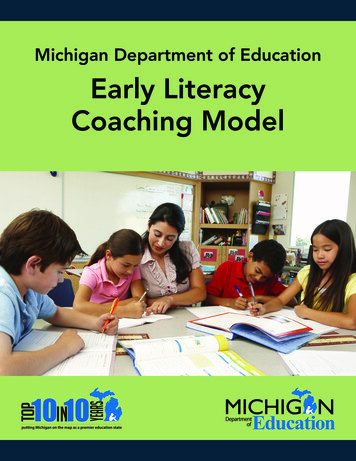
Transcription
Literacywww.fu t u r e o f ch i l d r e n . o r gThe Future of ChildrenLiteracy Challenges for theTwenty-First CenturyVO L U M E 2 2 N U M BE R 2 FA L L 2 0 1 23Volume 22 Number 2 Fall 2012A COLLABORATION OF THE WOODROW WILSON SCHOOL OF PUBLIC AND INTERNATIONAL AFFAIRS ATPRINCETON UNIVERSITY AND THE BROOKINGS INSTITUTIONLiteracy Challenges for the Twenty-First Century: Introducing the Issue17Patterns of Literacy among U.S. Students39The Role of Out-of-School Factors in the Literacy Problem55Improving Reading in the Primary Grades73Reading and Reading Instruction for Children from Low-Income andNon-English-Speaking Households89Adolescent Literacy: Learning and Understanding Content117The Importance of Infrastructure Development to High-Quality LiteracyInstruction139Technology Tools to Support Reading in the Digital AgeA COLLABORATION OF THE WOODROW WILSON SCHOOL OF PUBLIC AND INTERNATIONAL AFFAIRS ATPRINCETON UNIVERSITY AND THE BROOKINGS INSTITUTION
The Future of Children seeks to translate high-level research into information that is usefulto policy makers, practitioners, and the media.The Future of Children is a collaboration of the Woodrow Wilson School of Public andInternational Affairs at Princeton University and the Brookings Institution.Senior Editorial StaffJournal StaffSara McLanahanEditor-in-ChiefPrinceton UniversityDirector, Center for Research onChild Wellbeing, and William S. TodProfessor of Sociology and Public AffairsKris McDonaldAssociate EditorPrinceton UniversityJanet M. CurrieSenior EditorPrinceton UniversityDirector, Center for Health and Wellbeing,and Henry Putnam Professor of Economicsand Public AffairsRon HaskinsSenior EditorBrookings InstitutionSenior Fellow and Co-Director, Center onChildren and FamiliesCecilia RouseSenior EditorPrinceton UniversityDirector, Education Research Section,and Katzman-Ernst Professor in theEconomics of Education and Professor ofEconomics and Public AffairsIsabel SawhillSenior EditorBrookings InstitutionSenior Fellow, Cabot Family Chair, andCo-Director, Center on Children and FamiliesLauren MooreProject ManagerPrinceton UniversityBrenda SzittyaManaging EditorPrinceton UniversityBoard of AdvisorsLawrence BalterNew York UniversityCharles N. Kahn IIIFederation of American HospitalsJeanne Brooks-GunnColumbia UniversityMarguerite KondrackeAmerica’s Promise—The Alliance for YouthJudith FederGeorgetown UniversityRebecca MaynardUniversity of PennsylvaniaWilliam GalstonBrookings InstitutionUniversity of MarylandLynn ThomanCorporate PerspectivesJean B. GrossmanPrinceton UniversityKay S. HymowitzManhattan Institute for Policy ResearchHeather B. WeissHarvard UniversityAmy WilkinsEducation Reform NowMartha GottronManaging EditorPrinceton UniversityLisa Markman-PithersOutreach DirectorPrinceton UniversityReid QuadeOutreach CoordinatorBrookings InstitutionRegina LeidyCommunications CoordinatorPrinceton UniversityTracy MeroneAdministratorPrinceton UniversityThe views expressed in this publication do not necessarily represent the views of the WoodrowWilson School at Princeton University or the Brookings Institution.Copyright 2012 by The Trustees of Princeton UniversityThe Future of Children would like to thank The Annie E. Casey Foundation and the David andLucile Packard Foundation for their generous support.This work is licensed under the Creative Commons Attribution-NoDerivs 3.0Unported License, http://creativecommons.org/licenses/by-nd/3.0. Authorization to reproducearticles is allowed with proper attribution: “From The Future of Children, a collaboration of theWoodrow Wilson School of Public and International Affairs at Princeton University and theBrookings Institution.”ISSN: 1054-8289ISBN: 978-0-9814705-9-7To purchase a print copy, access free electronic copies, or sign up for our e-newsletter, go toour website, www.futureofchildren.org. If you would like additional information about thejournal, please send questions to foc@princeton.edu.
VOLUME 22N UMBER 2FAL L 2012Literacy Challenges for theTwenty-First Century3Literacy Challenges for the Twenty-First Century: Introducingthe Issue by Richard Murnane, Isabel Sawhill, and Catherine Snow17Patterns of Literacy among U.S. Students by Sean F. Reardon,Rachel A. Valentino, and Kenneth A. Shores39The Role of Out-of-School Factors in the Literacy Problemby Jane Waldfogel55Improving Reading in the Primary Grades by Nell K. Duke andMeghan K. Block73Reading and Reading Instruction for Children from Low-Incomeand Non-English-Speaking Households by Nonie K. Lesaux89Adolescent Literacy: Learning and Understanding Contentby Susan R. Goldman117The Importance of Infrastructure Development to High-QualityLiteracy Instruction by David K. Cohen and Monica P. Bhatt139Technology Tools to Support Reading in the Digital Age byGina Biancarosa and Gina G. Griffithswww.futureofchildren.org
Literacy Challenges for the Twenty-First Century: Introducing the IssueLiteracy Challenges for the Twenty-FirstCentury: Introducing the IssueRichard Murnane, Isabel Sawhill, and Catherine SnowAdvanced literacy is aprerequisite to adult successin the twenty-first century.By advanced literacy we donot mean simply the abilityto decode words or read a text, as necessaryas these elementary skills are. Instead wemean the ability to use reading to gain accessto the world of knowledge, to synthesizeinformation from different sources, toevaluate arguments, and to learn totally newsubjects. These higher-level skills are nowessential to young Americans who wish toexplore fields as disparate as history, science,and mathematics; to succeed in postsecondaryeducation, whether vocational or academic; toearn a decent living in the knowledge-basedglobalized labor market; and to participate ina democracy facing complex problems.The literacy challenge confronting children,their families, and schools in the UnitedStates has two parts. The first is the universalneed to better prepare students for twentyfirst-century literacy demands. The secondis the specific need to reduce the disparitiesin literacy outcomes between children fromdisadvantaged backgrounds and those frommore privileged homes.This issue of the Future of Childrenexplores the literacy of America’s childrenand how to improve it. We begin this introductory essay by reviewing briefly why literacyis so important in today’s world and why theconcept of literacy needs to be broadenedto include a set of competencies that go wellbeyond the ability to recognize words anddecode text. We end with a summary of theother articles in the issue and briefly considerwhat steps policy makers might take torespond to the urgent needs we cite.The Growing Demand forStrong Literacy SkillsThe “literacy problem” we address here isnot that literacy has declined among recentgenerations of children. It is that today’seconomy and the complex political and socialchallenges facing the nation demand moreadvanced skills than ever before.The average reading skill of non-Hispanicwhite children from recent cohorts isremarkably similar to that of comparablechildren born in the 1960s, and the averagereading achievement of recent cohorts ofblack children and Hispanic children isconsiderably higher than that of comparableRichard Murnane is the Thompson Professor of Education and Society at the Harvard Graduate School of Education; Isabel Sawhill is asenior fellow, Cabot Family Chair, and co-director of the Center on Children and Families, at the Brookings Institution; Catherine Snow isthe Patricia Albjerg Graham Professor of Education at the Harvard Graduate School of Education.VOL. 22 / NO. 2 / FALL 20123
Richard Murnane, Isabel Sawhill, and Catherine SnowFigure 1. National Assessment of Educational Progress Test Score Trends in Reading: NationalAverages for Thirteen-Year-Olds (Eighth Grade)280White270Black260LatinoScale 219941996199920042008Source: U.S. Department of Education, Institute of Education Sciences, National Center for Education Statistics, National Assessment ofEducational Progress (NAEP), various years, 1971–2008 Long-Term Trend Reading Assessments.cohorts born several decades ago. Thesepoints are illustrated in figure 1, whichpresents trends from the National Assessmentof Educational Progress in the averagereading levels of American thirteen-year-oldsin the major race and ethnicity groups.Although the literacy of American childrenhas not changed appreciably over the pastforty years, the American labor market haschanged dramatically. The change in thenation’s occupational structure is illustrated infigure 2, which displays the shares of workersemployed in large occupational groups,arrayed from lowest wage on the left tohighest wage on the right. The big declinesbetween 1979 and 2009 in the share ofworkers employed in particular occupationstook place in blue-collar jobs (for example,assembly line work) and administrativesupport (for example, filing). These jobsrequire workers who can read, but historicallythey have not demanded advanced literacyskills. Jobs have declined in these occupations4T H E F UT UR E OF C HI L DRE Nbecause they can be and have been taken overby computer-guided machines or by workersin lower-wage countries.1During those same three decades the demandfor workers in higher-paid occupations,for example, in technical and professionalfields, was growing. These jobs typicallyrequire postsecondary education or training,leaving workers with inadequate literacyskills competing for the growing number oflow-paying service jobs.Americans also need strong literacy skillsto participate constructively in a pluralisticdemocracy facing complex domestic andglobal challenges, including a large nationaldebt, global warming, and the proliferationof nuclear weapons. There is no shortage ofinformation about these challenges. Indeed,Internet searches turn up thousands ofdocuments and opinions on every one. Butsifting through the conflicting arguments andjudging which pieces of evidence hold up to
Literacy Challenges for the Twenty-First Century: Introducing the Issuescrutiny require significant literacy skills. Thenation’s ability to meet these challenges isquite likely to depend on the extent to whichthe electorate understands them.Another new challenge is the changing demographic composition of the nation’s children.As shown in figure 3, the share of the nation’schildren who are non-Hispanic whites isdeclining, while the share of Hispanic children is growing rapidly, and the share of blackchildren is holding relatively constant. As aresult, within the next thirty years, Hispanicand black children in the United States willoutnumber non-Hispanic white children. Asillustrated in figure 1, the literacy skills ofHispanic and black children are significantlylower, on average, than those of non-Hispanicwhite children. Unless the United States canmarkedly improve the literacy skills of today’sminority children the labor force of the futurewill have lower literacy skills than the laborforce of today.Large and Growing Gaps inLiteracy Skills by SocioeconomicStatusAs noted, our concern in this issue is not onlythe overall literacy skills of American students,but also the gaps between more and lessadvantaged children. The disparities associated with family income have grown markedlyover the past half century. Among childrenborn during the 1940s, the gap between theaverage reading achievement of those growingup in families at the 10th percentile of theincome distribution and those growing up infamilies at the 90th percentile of the incomedistribution was about 0.60 standard deviation.Among cohorts born in the first years of thetwenty-first century, the corresponding gap inaverage reading skills is twice as large, about1.25 standard deviations. That pattern,documented by sociologist Sean Reardon2 andillustrated in figure 3 of the article he and hiscolleagues wrote for this issue, is extremelytroubling.Figure 2. The Adult Occupational Distribution: 1979 and 20093519792009Percentage of employed adults302520151050ServiceBlue Professional Managers &occupations administratorsSource: Authors, based on tabulations of data from the Current Population Survey provided by Professor David Autor of MIT.Note: The data include all persons aged 16–64 who reported having worked last year, excluding those employed by the military and inagricultural occupations.VOL. 22 / NO. 2 / FALL 20125
Richard Murnane, Isabel Sawhill, and Catherine SnowHigh rates of intergenerational mobility havealways been central to the distinctivelyAmerican belief in opportunity, and educationis the primary mechanism driving upwardmobility. Low literacy levels among childrenfrom less advantaged families dramaticallyreduce the potential for upward mobility.Preliminary results from the BrookingsInstitution Social Genome Model show thatif the academic success rates of lower- andhigher-income children were roughly equal atthe end of elementary school, the lifetimeincomes of children from lower-incomeLiteracy Development: It’s NotJust Decoding and SummarizingAnymoreIf success in the twenty-first century dependsincreasingly on advanced literacy skillsand the education and training they makepossible, it is important for educators, policymakers, and the public to understand whatadvanced literacy is. In short, a new definitionof literacy is required—one that highlightsthe skills that children need to deal with thenew demands.Widely used assessments of reading comprehension typically treat it as a relatively shallowprocess—one that involves being able tofamilies could grow about 8 percent, orroughly 83,000, over their careers.3Figure 3. Percentage of Children Aged 0–17 in the United States by Race and Hispanic Origin,1980–2010 and Projected 2011–50.100Projected80PercentageWhite, non-Hispanic6040Black, non-HispanicHispanicAsian or Pacific Islander20BlackAmerican Indian or Alaskan NativeAll other racesAsian019801990200020102020203020402050Source: U.S. Census Bureau, Population Estimates and Projections, as found at: e1. Data from 2000 onward are not directly comparable with data from earlier years. Data on race and Hispanic origin arecollected separately; Hispanics may be any race. In 1980 and 1990, following the 1977 Office of Management and Budget (OMB)standards for collecting and presenting data on race, the decennial census gave respondents the option to identify with one race fromthe following: White, Black, American Indian or Alaskan Native, or Asian or Pacific Islander. The Census Bureau also offered an “Other”category. Beginning in 2000, following the 1997 OMB standards for collecting and presenting data on race, the decennial census gaverespondents the option to identify with one or more races from the following: White, Black, Asian, American Indian or Alaska Native, andNative Hawaiian or Other Pacific Islander. In addition, a “Some other race” category was included with OMB approval. Those who chosemore than one race were classified as “Two or more races.” Except for the “All other races” category, all race groups discussed from2000 onward refer to people who indicated only one racial identity. (Those who were “Two or more races” were included in the “All otherraces” category, along with American Indians or Alaska Natives and Native Hawaiians or Other Pacific Islanders.)6T H E F UT UR E OF C HI L DRE N
Literacy Challenges for the Twenty-First Century: Introducing the Issueremember (or quickly find) information read,to summarize a paragraph, to identify themain idea of a paragraph, and perhaps tomake simple inferences from information inthe text. These assessments typically requirereading a series of brief texts and respondingto multiple-choice questions based on themor perhaps selecting appropriate words to fillin blanks in the text. Assessments designed totap the skills that are directly relevant toacademic success and to workplace demandsrequire students to synthesize informationacross different sources, to evaluate argumentson a variety of dimensions, to understandvarying perspectives on an issue, and to assessthe credibility of sources of information—skills that we will call “deep comprehension.”Much literacy instruction in U.S. schools isguided, implicitly or explicitly, by “the simpleview” of reading.4 According to this view,reading comprehension depends on accuracyand speed of word reading and on oral understanding of the words to be read. The simpleview has had the salutary effect of ensuringthat educators recognize the need to includelanguage as well as word reading in earlyreading instruction. The utility of the simpleview declines, though, as the tasks used to tapcomprehension become more authentic andmore challenging. The simple view does anexcellent job of explaining comprehension ofthe sort that enables a young reader to answermultiple-choice questions about relativelybrief and effectively neutral texts. But it is lessadequate in reflecting deep comprehensionskills—those needed for reading to learn, tosynthesize, to analyze, and to critique.The simple view does not, for example, directmuch attention to issues of backgroundknowledge. Schema theories of readingcomprehension represent reading comprehension as a process of updating a reader’sknowledge schemas by integrating information encountered in text with informationalready stored.5 If the newly encounteredinformation confirms what is stored inmemory, then the reader can comprehendit with ease. If the new information conflictswith that stored in memory, then the readerneeds to analyze it for correctness, or at leastfor credibility, and decide whether to updatehis or her schema. If the new informationagrees with that stored in memory, perhapsextending it, then the reader can learn it relatively easily by updating his or her schema.Comprehension challenges rise when the textdeals with information unconnected to anyexisting schema in the reader’s knowledgebase. Such information is a challenge fordeveloping readers and continues to be anobstacle for mature, skilled readers.Americans struggle to understand newspaperreports of cricket matches, just as Britishsports fans do with reports of baseball games.The schemas on which to hang descriptions ofruns, innings, outs, and points are specific tothe two games and constitute the backgroundrequired for comprehension.Ironically, then, one of the most importantinputs to successful reading comprehension isknowledge, some of it acquired withoutreading at all. One major difference betweenchildren likely to become good readers andthose likely to struggle is vocabulary knowledge. As early as age three, middle-class anddisadvantaged children display enormousdifferences in the size of their vocabulary,because they have had differing experienceswith conversations from which they can learnnew things.6 Vocabulary is a convenient indexof breadth of knowledge. Knowledge createsthe framework on which reading comprehension builds.VOL. 22 / NO. 2 / FALL 20127
Richard Murnane, Isabel Sawhill, and Catherine SnowLiteracy Instruction: The Idealand the RealExcellent reading instruction, then, balancesattention to the skills required for accurateand fluent word reading with opportunitiesto expand students’ knowledge and language.Ideally, both these goals are kept in mind atevery stage of instruction. In far too manyU.S. classrooms, though, attention to languageand to knowledge building is severely diminished starting in kindergarten, when letters,then letter-sound pairings, then word readingabsorb all the instructional attention.PreschoolGood early childhood education providesopportunities to learn emergent literacyskills—to identify letters, to recognizefrequently encountered words like “stop” or“exit,” to write one’s own name, to know whatsounds the initial letters of a word represent,to rhyme, to use knowledge of letter namesand letter sounds to produce invented spellings. Reading aloud is often incorporated byteachers into this emergent literacy agendaand is used as an opportunity to point outwords and letters in meaningful contexts.The value of these emergent literacy activities is undeniable. They predict children’sskills at kindergarten entry, and children whodo better at letter recognition, phonologicalawareness tasks, and reading words as fiveyear-olds are very likely to have an easier timelearning to read. Children of low-incomefamilies are more likely to spend time inunder-resourced and informal child caresettings (see the article by Jane Waldfogel),where they have less access to these activitiesand where they miss opportunities to helpthem catch up to their middle-class peers.Children from families with more financialand cultural resources differ from their less8T H E F UT UR E OF C HI L DRE Nadvantaged peers, though, not just in knowledge of these early literacy skills but also inaccess to knowledge about topics related tothe natural world (bugs, flowers, tidal pools),to astronomy (what shape the world is, whythe sun sets), to current events (who thepresident is, what a mayor does, what a budgetis), to history (why the Civil War was fought,who George Washington was), to humanrelations (how aunts and uncles are related tothem, what divorce means). These differencesare indexed by enormous social class differences in vocabulary and are produced bydifferential access to oral language interactions, exacerbated by differential access toengaging and language-rich books read aloud,both in the home and in early child caresettings. Early childhood programs thatprovide such engaging and language-richexperiences do exist, and preschool practicesfocused on developing language and enrichingknowledge have been shown to be effective.7Unfortunately, they are not widespread.Primary GradesLiteracy instruction in the primary grades ofAmerican schools is generally dominated bypractices designed to ensure accurate andfluent decoding of grade-level texts by the endof grade three. Third-grade texts look like this:It was a fine summer morning,So Frances took out her bat and ball.“Will you play ball with me?”said her little sister, Gloria.“No,” said Frances.“You are too little.”Gloria sat down and cried.Frances walked over to her friendAlbert’s house, singing a song:Sisters that are much too smallTo throw or catch or bat a ballAre really not much good at allExcept for crying.8
Literacy Challenges for the Twenty-First Century: Introducing the IssueTexts like this, however charming, offer littleopportunity to grapple with deep comprehension. That is entirely appropriate because thetechnical challenges of reading English aresufficiently daunting that most students needlots of help and lots of practice to get good atit. Practicing deep comprehension while stillstruggling to decode multisyllabic words maysimply be too hard.On the other hand, children in the primarygrades can practice some aspects of deepcomprehension while listening to texts readaloud. They are capable of discussing andevaluating competing interpretations of acharacter’s actions and competing explanations for physical phenomena. They arecapable of integrating information fromdifferent sources, if they have access to thosesources with the help of pictures, read-alouds,and videos, or help from better readers.Observations suggest that primary-gradeinstruction devotes remarkably little timeto science, civics, current events, or socialstudies, perhaps because of the accountability pressures to ensure that all studentsleave third grade reading at the third-gradelevel. Thus, children have the opportunity tolearn reading as a tool, but the content thatwould support their later use of that tool forpurposes of comprehension and further learning may be neglected.Middle GradesFor most American students, ongoing literacyinstruction takes place primarily in Englishlanguage arts after third grade. In grades fourand five, English language arts typically offersa variety of text genres and tasks, and studentswho are still having difficulty learning to readare likely to receive special help. The selfcontained classroom model that predominatesthrough grade five facilitates flexible use oftime and some level of attention to literacyacross the curriculum.During the transition to the departmentalizedstructure of grades six through eight, literacyinstruction is severed from content instructionfor many students. Excellent readers do notsuffer under this regimen; they take the reading skills they have acquired, so far practicedpredominantly on fiction in most cases, andadapt them to the reading of science andhistory textbooks. Well-informed studentsare also unlikely to suffer; they may alreadyknow, from dinner table conversations or fromwatching PBS and the History Channel, quitea bit about genetic inheritance, survival of thefittest, and the Civil War, so they have richlyelaborated schemas on which to hang the newinformation to which their texts expose them.But students with marginal reading skills,and good readers with limited knowledgestores, encounter new and often insurmountable tasks. No one teaches them how to readscience or history, often because their historyand science teachers are unaware of thedegree to which the literacy demands of theirtexts deviate from those of books read earlier,but also because they do not know how toteach reading.Researchers have devised and evaluatedspecific procedures that teachers can use tosupport the growth of reading skills in thepostprimary grades. These procedures have incommon helping students establish a purposefor reading, modeling how to work actively tounderstand text, providing strategies tosupport them in accessing the text, providingexplicit instruction about differences in genresand discourse structures across differentcontent areas, teaching crucial presupposedknowledge (vocabulary and information)before exposing students to the text, andVOL. 22 / NO. 2 / FALL 20129
Richard Murnane, Isabel Sawhill, and Catherine Snowrequiring demonstrations of deep understanding (oral and written reports). The procedureshave been packaged into various approaches,curricula, and programs. They have not beenused as widely, or as well, as the nation requires.The Challenge and a Summaryof the Articles in the IssueGiven the economic demands, the educational challenges, and students’ needs fortwenty-first-century literacy skills, this issueexplores what is known about current levels ofliteracy, their determinants, and new strategies to improve literacy.Trends in Literacy Levels and GapsSean Reardon, Rachel Valentino, andKenneth Shores, all of Stanford University,provide a detailed look at how well U.S.students are performing. They find that abouttwo-thirds of fourth graders, three-fourths ofeighth graders, and three-fourths of twelfthgraders were reading at a “basic” level in2011. About one-third of students at eachgrade level were reading at a “proficient”level. Over the past forty years literacy skillsscores on assessment tests have not improvedmuch—in sharp contrast to sizable increasesin math scores over this same period. Thegaps in literacy skills by socioeconomic statusand race are striking. Throughout elementaryand middle school, girls consistently scoreabout 0.2 standard deviation above boys; theblack-white and Hispanic-white gaps areeach about 0.6 standard deviation; and theincome gap (10th vs. 90th percentile of familyincome) is larger still.While the black-white and Hispanic-whitegaps have narrowed somewhat over thepast forty years, the socioeconomic gap haswidened, and the gender gap has not changed.These gaps do not typically narrow as children progress through school. Indeed, they10T H E F UT UR E OF C HI LDRE Nsometimes widen. For example, the blackwhite gap increases between kindergartenand third grade and widens further by eighthgrade. U.S. scores are about, or a little above,average compared with those in other developed countries for similarly aged children. Theauthors conclude that literacy skills need to beimproved. They take the narrowing of racialgaps in the past and the reasonable successschools have had in improving math skills asevidence that literacy skills are malleable.Nonschool FactorsBecause literacy gaps are present whenchildren start school, nonschool factors suchas families and communities must play a rolein the acquisition of literacy skills and likelycontinue to exert an influence as children age.Jane Waldfogel, of Columbia University, usesthe differences between subgroups (by race,socioeconomic status, and immigrant status)to tease out what these influences might be.She notes that parents are critical to children’searly literacy. More advantaged parents aremore responsive to their children, interactwith them more frequently, and provide aricher learning environment through readingand other cognitively stimulating activities,such as use of a computer or visits to a library.Other factors playing a role in the acquisition of early literacy skills that vary with raceor socioeconomic status include health andhealth-related behaviors and participation inpreschool.The reading gaps between black and whitechildren are especially troubling because notonly are they evident when children startschool but they grow larger during the schoolyears. In contrast, although Hispanic childrenstart out behind (perhaps because of stilllimited English skills and lower levels ofparticipation in preschool), the gaps withwhites narrow or stabilize after a few years. A
Literacy Challenges for the Twenty-First Century: Introducing the IssueThe reading gaps betweenblack and white childrenare especially troublingbecause not only are theyevident when children startschool but they grow largerduring the school years. Incontrast, although Hispanicchildren start out behind, thegaps with whites narrow orstabilize after a few years.variety of nonschool factors could be playing ar
VOLUME 22 NUMBER 2 FALL 2012 Literacy Challenges for the Twenty-First Century 3 Literacy Challenges for the Twenty-First Century: Introducing the Issue by Richard Murnane, Isabel Sawhill, and Catherine Snow 17atterns of Literacy among U.S. Students P by Sean F. Reardon, Rachel A. Valentino, and Kenneth A. Shores 39 The Role of Out-of-School Factors in the Literacy Problem










